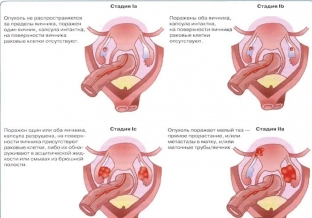Ovarian cancer is the first cause of death among all gynecological oncology. This severe disease affects women of all ages, but most often the pathology occurs in postmenopausal women. Features of the pathogenesis and etiology of ovarian cancer make it difficult to prevent the development of this disease. Depending on the stage of the malignant process and its prevalence, ovarian cancer manifests itself with various symptoms. Detection of the disease at an early stage and effective treatment significantly improve the survival prognosis for these patients.
Clinical presentation and classification of ovarian cancer
Ovarian cancer today occurs in women of various age categories and ethnic groups. It is generally accepted that factors such as environmental pollution, unhealthy diet and socioeconomic conditions predispose to the development of ovarian cancer. That is why it is not surprising that the prevalence of pathology among the population of economically developed countries is quite high. The importance of timely preventive examinations by a gynecologist is undeniable, since ovarian cancer, like many other oncological pathologies, may not manifest itself in any way in the early stages of the disease.
Ovarian cancer:
- three theories of ovarian cancer;
- classification of ovarian cancer by occurrence and spread;
- clinical picture of ovarian cancer: symptoms of the spread of pathology.
Three theories of ovarian cancer
The etiological factors of malignant ovarian tumors remain not reliably studied today. There are three main theories of ovarian cancer:
- Hyperestrogenia - with hyperactivity of the hypothalamic-pituitary system in a woman's body, estrogen can be produced in excess, which creates favorable conditions for the tumor transformation of ovarian cells.
- "Continuous ovulation" - in the case of early onset of menarche, late menopause, with a small number of pregnancies and shortening of the lactation period, ovulation occurs very often in the woman's body, during which the cortical layer of the ovary is damaged, which increases the likelihood of ovarian cancer.
- Genetic Predisposition - Women with a family history of breast or ovarian cancer are more likely to develop this cancer.
Classification of ovarian cancer by occurrence and spread of the process
There are three main types of ovarian cancer: primary, secondary, and metastatic. In primary ovarian cancer, the ovary is damaged by a malignant process. In the case of secondary ovarian cancer, malignancy of benign or borderline ovarian tumors occurs. Metastatic cancer or Krukenberg's tumor is characterized by the presence of a primary focus in other organs, such as the stomach, breast, uterus, intestines, or thyroid gland. The ovary is affected by metastases of these tumors, as a result of which a malignant process develops directly in this organ. Depending on the prevalence of the oncological process, it is customary to distinguish 4 main stages of ovarian cancer:
- Stage 1 - Tumor affects only the ovaries;
- stage 2 - malignant process spreads to the pelvic area;
- Stage 3 - Both ovaries are affected with peritoneal metastases outside the pelvis, or retroperitoneal lymph node metastasis is observed.
- Stage 4 - develops ovarian cancer with distant metastases.

Clinical picture of ovarian cancer: symptoms of the spread of the process
The peculiarity of the clinical picture of ovarian cancer is that there are no symptoms of damage to the ovaries proper in this cancer. Pain syndrome can occur only if the torsion of the tumor stem is observed, and a clinic of an acute abdomen occurs. When the pathological process spreads to the pelvic organs or the tumor metastasizes, symptoms such as general weakness, decrease and distortion of appetite, fever, and signs of dysfunction of the gastrointestinal tract may occur. When ascites occurs, the patient has a significant increase in the abdomen. Pleural effusion may also be seen. In the advanced stages of the disease, swelling of the lower extremities and symptoms of cardiovascular and respiratory failure occur.






Add a comment